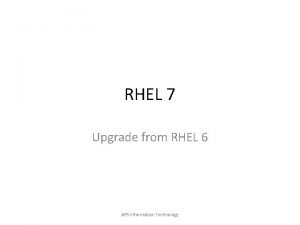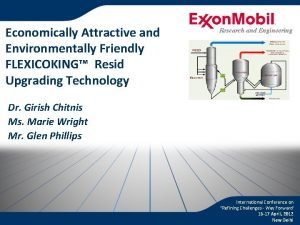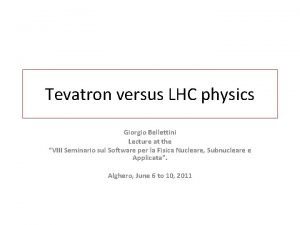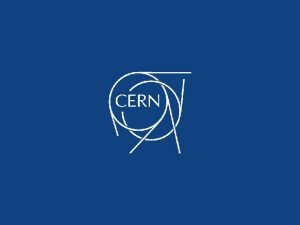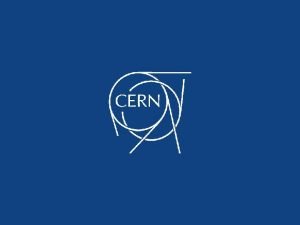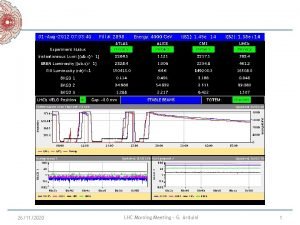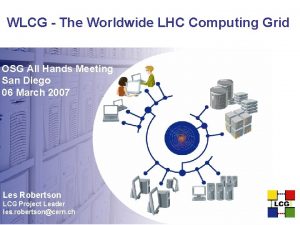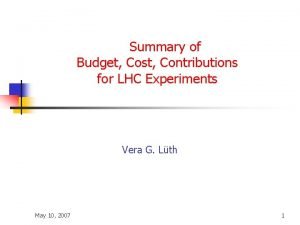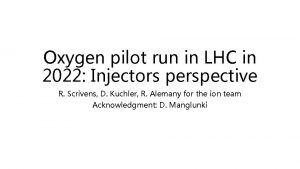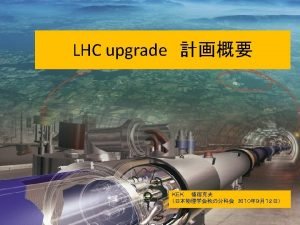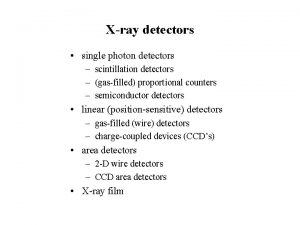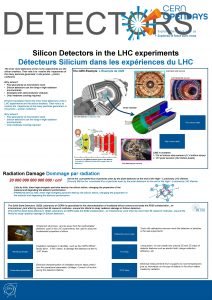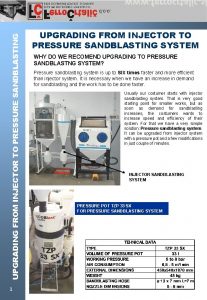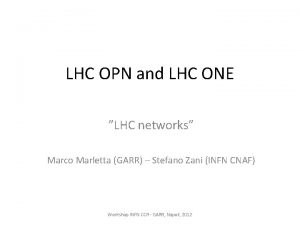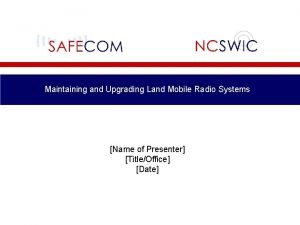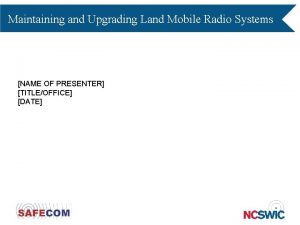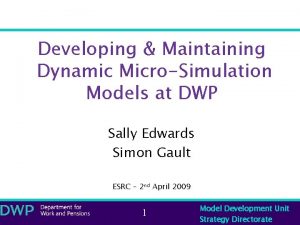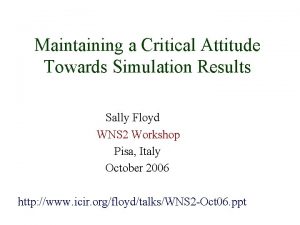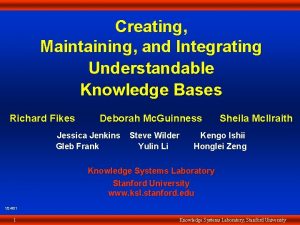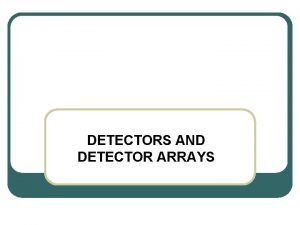Operating Maintaining and Upgrading the LHC Detectors Sally

























- Slides: 25

Operating, Maintaining, and Upgrading the LHC Detectors Sally Seidel University of New Mexico National Science Foundation February 21, 2003 1

Faces in the future of the LHC program. . . Philip Watje (UNM ‘ 04) and Amanda Burghard (UNM ‘ 05) at work in the silicon laboratory at the University of New Mexico, characterizing production pixel sensors for 2 ATLAS.

The salaries of these undergraduate students, and the equipment that they use, are provided by NSF and US-ATLAS. Without these funds, these straight-A physics majors would be supporting themselves with non -science, minimum-wage jobs in Albuquerque. Because of this lab experience, they’ve begun talking about LHC Ph. D. ’s. The NSF program is bringing research skills and excitement to the next generation right now. This talk is about the impact of detector maintenance and operations and detector upgrades on the science that they and we all want to do. 3

Maintenance and Operations Through NSF support, U. S. universities’ scientists have built upon experience in previous large experiments and assembled teams that are producing major subsystems of the ATLAS and CMS detectors. The ATLAS cryostat, supported by NSF 4

~20 cm ~6, 000 CMS Tracker Outer Barrel modules will be constructed in the U. S. 5

• The U. S. Deliverables are on track to meet LHC schedules. This includes almost 50 university-based construction efforts. • U. S. groups have provided leadership in many areas of design and construction. Outstanding examples of U. S. leadership on the LHC projects: • U. S. -CMS • constructing the entire forward pixel system • responsible for endcap muon chambers and electronics • leadership on hadron calorimeter barrel construction and all electronics 6

• U. S. - ATLAS • 7 -university collaboration to build hundreds of square meters of the Monitored Drift Tube muon tracking detectors (25 m accuracy), including electronic readout and laser alignment • 4 -university collaboration building major portion of transition radiation tracker including advanced electronics 7

Hampton University’s clean room, where parts are prepared and tested for the ATLAS Barrel Transition Radiation Tracker 8

• Continued leadership during the maintenance and operations (M&O) phase is a natural path to leadership in extraction of the data. • M&O includes • final testing, including supplies • calibration • integration • monitoring • maintenance, including spares, tooling • support of common costs, consumables, surface infrastructure • U. S. M&O responsibilities are commensurate with the U. S. responsibilities during construction. 9

Subsystem responsibilities by U. S. groups extend broadly and deeply in both ATLAS and CMS: • ATLAS M&O tasks deriving directly from construction responsibilities: • Semiconductor tracker (SCT): subsystem management, system engineering, electronics coordination; monitoring, annealing, calibrating optical links; maintaining, monitoring flex hybrids. . . 10

• Transition Radiation Tracker (TRT): checkout, installation, integration, maintenance • Liquid Argon Calorimeter (LAr): readout electronics, HV feedthroughs and cables, monitoring software, integration • Scintillating Tile Hadronic Calorimeter (Tile. Cal): pre-assembly, calibration, installation, pre-operations • Muon spectrometer: certification of chambers and alignment components, preoperation, testing and debugging, system tests • Trigger and data acquisition (TDAQ): software development, changes, and maintenance; troubleshooting and repair; rolling replacement of processors and network components 11

U. S. ATLAS skill mix needed to achieve the task of M&O. . . 12

CMS construction responsibilities leading to M&O responsibilities: • Silicon strip tracker (Si. Trkr): full tracker outer barrel assembly • Forward pixels (FPIX): full system 13

• Electromagnetic calorimeter (ECAL): barrel transducers, front end electronics, laser monitor • Hadronic calorimeter (HCAL): barrel and outer barrel, endcap and forward transducers and readout, endcap scintillator, and forward quartz fibers • Muon system (EMU): cathode strip chambers, electronics, and readout • Trigger/Data Acquisition (TRIDAS): Level-1 endcap muon and calorimeter triggers, DAQ filter 14

U. S. CMS M&O Estimated Personnel Needs 15

Upgrade • Phases: • LHC luminosity will increase during the first 4 -5 years to 1034 cm-2 s-1. • Modest LHC upgrades should increase luminosity to 1035 cm-2 s-1 after that, extending the observable mass range by 20%. • Possible subsequent energy doubling upgrade being studied would double the mass range. 16

• Implications: • increased radiation resistance needed in many systems. • increased granularity of tracking needed. • trigger innovations; rate capability management required. • Timescale for upgrades: 2012 -2015 • Timescale needed for R&D: starting now 17

Physics motivation for the luminosity upgrade: • The full precision of the LHC detectors becomes attainable: Higgs measurements reach statistics comparable to systematics as H Z and H and rarer modes become accessible. • For 170 < m. H < 200 Ge. V, final states with Higgs pairs are produced, allowing first measurement of Higgs self coupling. • Three gauge boson final states become accessible. Precision measurements of boson self-couplings improve substantially, in some cases comparable to electroweak corrections, probing extensions of the Standard Model for which these couplings are not uniquely fixed. 18

• The discovery mass reach for new phenomena expands with increased access to rare high transverse energy and missing transverse energy events. Sensitivity to the scale of large extra dimensions improves by ~25%; the overall scale for discovery of new processes increases by ~30%. 19

Impact of accelerator luminosity on the detectors: • baseline LHC operation may reveal new physics which would reasonably invite detector improvement. • For L= 1035 cm-2 s-1, tracking systems require new technology and significant engineering for • improved rad hardness (new materials, new geometries, small feature size electronics, cooling, power distribution) • improved granularity (mean 104 tracks per crossing) 20

These new tracking technologies naturally lead to • Improved precision at small radii (tagging short-lived particles such as b and ) • Improved precision at large radii (improved fractional accuracy of highest momentum tracks) In this environment, technologies that reduce detector mass and enhance triggering capability should naturally be examined as well. R&D for the current tracking systems began > 10 years ago. 21

• Calorimeters: • need new technologies for rad hard electronics • studies required of space charge effects, current-induced voltage drops • new liquids and gasses should be examined • Muon systems: • may need additional shielding at high when LHC data are available. • increased angular coverage to observe decay chains of new rare decays and angular distributions of 2 -body events, which are sensitive to new particle quantum numbers. 22

• Trigger, DAQ systems should respond dynamically to discoveries and opportunities: • Level 1 must respond to reduction of bunch crossing interval • High level triggers must respond to increased rate and event size • Associated research in readout network, complexity handling, implementation of network technology should keep pace. • Integration (services, support, interfaces, beam pipe) for all above. 23

U. S. ATLAS projected costs, FY'03 -’ 08 U. S. CMS projected M&O costs, FY’ 02 -’ 10 24

A conclusion. . . in its support for maintenance and operations. . . NSF is investing in the scientific and technological future of the U. S. 25
 Upgrade rhel 5 to 6
Upgrade rhel 5 to 6 Flexi coking
Flexi coking Where are feature detectors located
Where are feature detectors located Kinesthesis and vestibular sense
Kinesthesis and vestibular sense Feature vectors
Feature vectors Feature detectors
Feature detectors Frontier detectors for frontier physics
Frontier detectors for frontier physics Yodsawalai chodpathumwan
Yodsawalai chodpathumwan What is thermal detector
What is thermal detector Streaming current
Streaming current Vhv voltage detectors
Vhv voltage detectors Photo detectors
Photo detectors Nuclear detectors
Nuclear detectors Detectors used in hplc
Detectors used in hplc Giant wave detectors murmurs universe
Giant wave detectors murmurs universe Gravitational wave hear murmurs universe
Gravitational wave hear murmurs universe Sally and her family
Sally and her family Bellettini
Bellettini Lhc baton rouge
Lhc baton rouge Hl-lhc schedule
Hl-lhc schedule Hep forum
Hep forum Lhc logbook
Lhc logbook Lhc morning meeting
Lhc morning meeting Worldwide lhc computing grid
Worldwide lhc computing grid Lhc budget
Lhc budget Lhc schedule 2022
Lhc schedule 2022
